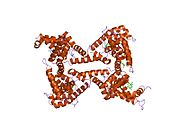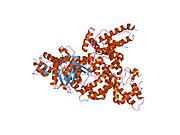Chemistry:Vitamin D-binding protein
 Generic protein structure example |
Vitamin D-binding protein (DBP), also/originally known as gc-globulin (group-specific component), is a protein that in humans is encoded by the GC gene.[1][2] DBP is genetically the oldest member of the albuminoid family and appeared early in the evolution of vertebrates.[3]
Structure
Human GC is a glycosylated alpha-globulin, ~58 kDa in size. Its 458 amino acids are coded for by 1690 nucleotides on chromosome 4 (4q11–q13). The primary structure contains 28 cysteine residues forming multiple disulfide bonds. GC contains 3 domains. Domain 1 is composed of 10 alpha helices, domain 2 of 9, and domain 3 of 4.[4]
Function
Vitamin D-binding protein belongs to the albumin gene family, together with human serum albumin and alpha-fetoprotein. It is a multifunctional protein found in plasma, ascitic fluid, cerebrospinal fluid and on the surface of many cell types.
It is able to bind the various forms of vitamin D including ergocalciferol (vitamin D2) and cholecalciferol (vitamin D3), the 25-hydroxylated forms (calcifediol), and the active hormonal product, 1,25-dihydroxyvitamin D (calcitriol). The major proportion of vitamin D in blood is bound to this protein. It transports vitamin D metabolites between skin, liver and kidney, and then on to the various target tissues.[2][5]
As Gc protein-derived macrophage activating factor it is a Macrophage Activating Factor (MAF) that has been tested for use as a cancer treatment that would activate macrophages against cancer cells.[6]
Interactive pathway map
Production
It is synthesized by hepatic parenchymal cells and secreted into the blood circulation.[5]
Regulation
The transcription factors HFN1α is a positive regulator while HFN1β is a dominant negative regulator of DBP expression.[7]
Variation
Many genetic variants of the GC gene are known. They produce 6 main haplotypes and 3 main protein variants (Gc1S, Gc1F and Gc2).[8] The genetic variations are associated with differences in circulating 25-hydroxyvitamin D levels.[9] They have been proposed to account for some of the differences in vitamin D status in different ethnic groups,[10] and have been found to correlate with the response to vitamin D supplementation.[8]
References
- ↑ "Possible localization of Gc-System on chromosome 4. Loss of long arm 4 material associated with father-child incompatibility within the Gc-System". Human Heredity 27 (2): 105–7. Jul 1977. doi:10.1159/000152857. PMID 558959.
- ↑ 2.0 2.1 "Entrez Gene: GC group-specific component (vitamin D binding protein)". https://www.ncbi.nlm.nih.gov/sites/entrez?Db=gene&Cmd=ShowDetailView&TermToSearch=2638.
- ↑ Bouillon, R.; Schuit, F.; Antonio, L.; Rastinejad, F. (2020). "Vitamin D Binding Protein: A Historic Overview". Frontiers in Endocrinology 10: 910. doi:10.3389/fendo.2019.00910. PMID 31998239.
- ↑ "A structural basis for the unique binding features of the human vitamin D-binding protein". Nature Structural Biology 9 (2): 131–6. February 2002. doi:10.1038/nsb754. PMID 11799400.
- ↑ 5.0 5.1 "From vitamin D to hormone D: fundamentals of the vitamin D endocrine system essential for good health". The American Journal of Clinical Nutrition 88 (2): 491S–499S. August 2008. doi:10.1093/ajcn/88.2.491S. PMID 18689389.
- ↑ "Immunotherapy for Prostate Cancer with Gc Protein-Derived Macrophage-Activating Factor, GcMAF" ([PDF]). Translational Oncology 1 (2): 65–72. July 2008. doi:10.1593/tlo.08106. PMID 18633461. PMC 2510818. http://www.transonc.com/pdf/manuscript/v01i02/neo08106.pdf.
- ↑ "Vitamin D Binding Protein: A Historic Overview". Frontiers in Endocrinology 10: 910. 2019. doi:10.3389/fendo.2019.00910. PMID 31998239.
- ↑ 8.0 8.1 "Common variants of the vitamin D binding protein gene and adverse health outcomes". Critical Reviews in Clinical Laboratory Sciences 50 (1): 1–22. January–February 2013. doi:10.3109/10408363.2012.750262. PMID 23427793.
- ↑ "A systematic review of the association between common single nucleotide polymorphisms and 25-hydroxyvitamin D concentrations". The Journal of Steroid Biochemistry and Molecular Biology 121 (1–2): 471–7. July 2010. doi:10.1016/j.jsbmb.2010.03.073. PMID 20363324.
- ↑ "Vitamin D-binding protein and vitamin D status of black Americans and white Americans". The New England Journal of Medicine 369 (21): 1991–2000. November 2013. doi:10.1056/NEJMoa1306357. PMID 24256378.
Further reading
- "Molecular basis for the three major forms of human serum vitamin D binding protein (group-specific component)". Biochemistry 18 (8): 1611–7. April 1979. doi:10.1021/bi00575a036. PMID 218624.
- "Molecular analysis of the gene for the human vitamin-D-binding protein (group-specific component): allelic differences of the common genetic GC types". Human Genetics 89 (4): 401–6. June 1992. doi:10.1007/BF00194311. PMID 1352271.
- "Receptor-mediated uptake and processing of vitamin D-binding protein in human B-lymphoid cells". The Journal of Biological Chemistry 267 (14): 10177–83. May 1992. doi:10.1016/S0021-9258(19)50216-2. PMID 1374401.
- "Chromosomal localization in man and rat of the genes encoding the liver-enriched transcription factors C/EBP, DBP, and HNF1/LFB-1 (CEBP, DBP, and transcription factor 1, TCF1, respectively) and of the hepatocyte growth factor/scatter factor gene (HGF)". Genomics 13 (2): 293–300. June 1992. doi:10.1016/0888-7543(92)90245-N. PMID 1535333.
- "Treatment of Haemophilus aphrophilus endocarditis with ciprofloxacin". The Journal of Infection 24 (3): 317–20. May 1992. doi:10.1016/S0163-4453(05)80037-4. PMID 1602151.
- "Mapping and conservation of the group-specific component gene in mouse". Genomics 7 (4): 509–16. August 1990. doi:10.1016/0888-7543(90)90193-X. PMID 1696927.
- "Evolutionary and structural relationships among the group-specific component, albumin and alpha-fetoprotein". Nucleic Acids Research 13 (22): 8007–17. November 1985. doi:10.1093/nar/13.22.8007. PMID 2415926.
- "Human group-specific component (Gc) is a member of the albumin family". Proceedings of the National Academy of Sciences of the United States of America 82 (23): 7994–8. December 1985. doi:10.1073/pnas.82.23.7994. PMID 2415977. Bibcode: 1985PNAS...82.7994Y.
- "Serum vitamin D-binding protein is a third member of the albumin and alpha fetoprotein gene family". The Journal of Clinical Investigation 76 (6): 2420–4. December 1985. doi:10.1172/JCI112256. PMID 2416779.
- "Complete amino acid sequence of human vitamin D-binding protein (group-specific component): evidence of a three-fold internal homology as in serum albumin and alpha-fetoprotein". Biochimica et Biophysica Acta (BBA) - Protein Structure and Molecular Enzymology 871 (2): 189–98. June 1986. doi:10.1016/0167-4838(86)90173-1. PMID 2423133.
- "Herpes simplex virus glycoproteins gC-1 and gC-2 bind to the third component of complement and provide protection against complement-mediated neutralization of viral infectivity". The Journal of Experimental Medicine 166 (5): 1525–35. November 1987. doi:10.1084/jem.166.5.1525. PMID 2824652.
- "The vitamin D-binding protein gene contains conserved nucleotide sequences that respond to heavy metal, adipocyte and mitotic signals". Gene 54 (2–3): 285–90. 1987. doi:10.1016/0378-1119(87)90499-9. PMID 2958390.
- "Direct regional assignment of the gene for vitamin D binding protein (Gc-globulin) to human chromosome 4q11-q13 and identification of an associated DNA polymorphism". Human Genetics 73 (3): 225–9. July 1986. doi:10.1007/BF00401232. PMID 3015768.
- "Detection of vitamin D binding protein on the surface of cytotrophoblasts isolated from human placentae". Endocrinology 120 (5): 1996–2002. May 1987. doi:10.1210/endo-120-5-1996. PMID 3552627.
- "Monoclonal antibodies to human vitamin D-binding protein". Proceedings of the National Academy of Sciences of the United States of America 82 (24): 8429–33. December 1985. doi:10.1073/pnas.82.24.8429. PMID 3936035. Bibcode: 1985PNAS...82.8429P.
- "Identification of a major endogenous substrate for phospholipid/Ca2+-dependent kinase in pancreatic acini as Gc (vitamin D-binding protein)". FEBS Letters 191 (1): 97–101. October 1985. doi:10.1016/0014-5793(85)81001-2. PMID 4054306.
- "Binding of the apo and holo forms of the serum vitamin D-binding protein to human lymphocyte cytoplasm and membrane by indirect immunofluorescence". Immunology Letters 3 (3): 159–62. August 1981. doi:10.1016/0165-2478(81)90120-6. PMID 7026425.
- "Sequence and organization of the human vitamin D-binding protein gene". Biochimica et Biophysica Acta (BBA) - Gene Structure and Expression 1216 (3): 385–94. December 1993. doi:10.1016/0167-4781(93)90005-x. PMID 7505619.
- "Affinity purification of human plasma vitamin D-binding protein". Protein Expression and Purification 6 (2): 185–8. April 1995. doi:10.1006/prep.1995.1023. PMID 7606167.
External links
- Overview of all the structural information available in the PDB for UniProt: P02774 (Vitamin D-binding protein) at the PDBe-KB.
 |







